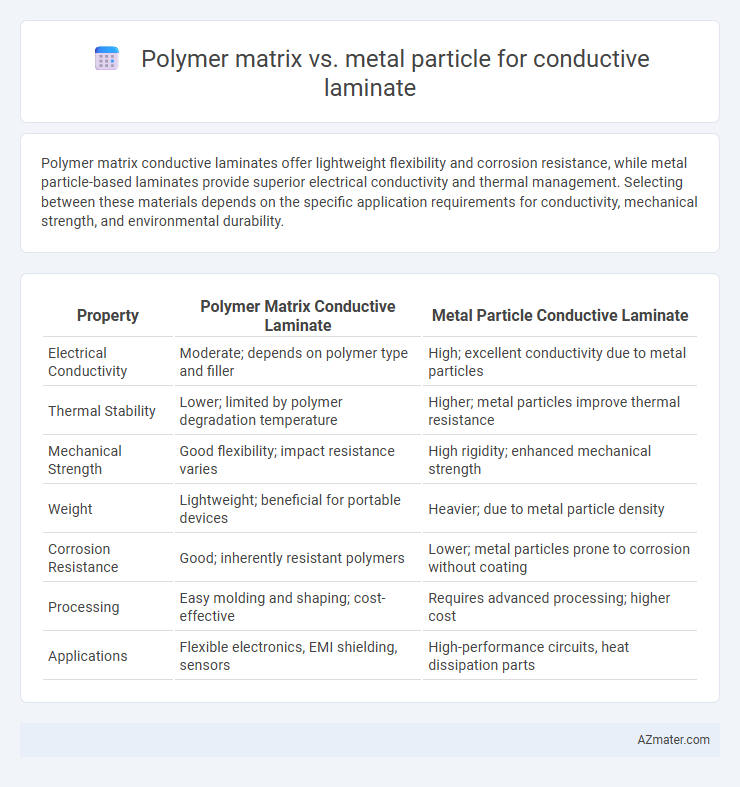Polymer matrix conductive laminates offer lightweight flexibility and corrosion resistance, while metal particle-based laminates provide superior electrical conductivity and thermal management. Selecting between these materials depends on the specific application requirements for conductivity, mechanical strength, and environmental durability.
Table of Comparison
| Property | Polymer Matrix Conductive Laminate | Metal Particle Conductive Laminate |
|---|---|---|
| Electrical Conductivity | Moderate; depends on polymer type and filler | High; excellent conductivity due to metal particles |
| Thermal Stability | Lower; limited by polymer degradation temperature | Higher; metal particles improve thermal resistance |
| Mechanical Strength | Good flexibility; impact resistance varies | High rigidity; enhanced mechanical strength |
| Weight | Lightweight; beneficial for portable devices | Heavier; due to metal particle density |
| Corrosion Resistance | Good; inherently resistant polymers | Lower; metal particles prone to corrosion without coating |
| Processing | Easy molding and shaping; cost-effective | Requires advanced processing; higher cost |
| Applications | Flexible electronics, EMI shielding, sensors | High-performance circuits, heat dissipation parts |
Introduction to Conductive Laminates
Conductive laminates integrate polymer matrices and metal particles to achieve optimal electrical conductivity and structural integrity in electronic applications. Polymer matrix composites provide flexibility, lightweight properties, and ease of processing, while metal particles such as silver or copper enhance electrical pathways and improve conductivity. The balance between polymer insulation and metal conductivity defines performance characteristics critical for printed circuit boards and flexible electronics.
Overview of Polymer Matrix Materials
Polymer matrix materials in conductive laminates primarily consist of thermosetting resins such as epoxy, phenolic, and bismaleimide, chosen for their excellent electrical insulation and mechanical properties. These polymers provide a lightweight, flexible, and corrosion-resistant base that enhances the laminate's durability and processability compared to metal matrices. Their inherent low dielectric constant and thermal stability make them ideal for high-frequency and high-performance electronic applications.
Overview of Metal Particle Fillers
Metal particle fillers in conductive laminates offer enhanced electrical conductivity and mechanical strength compared to polymer matrices alone. Common metal fillers include silver, copper, and nickel particles, each providing unique conductivity levels and corrosion resistance properties crucial for printed circuit board applications. The particle size, shape, and distribution significantly influence the laminate's overall conductivity, thermal stability, and durability in electronic devices.
Electrical Conductivity Comparison
Polymer matrix composites with metal particles exhibit varied electrical conductivity depending on the filler type, concentration, and dispersion quality. Metal particle-based conductive laminates, such as those containing silver or copper, typically offer superior electrical conductivity due to the inherent high conductivity of the metal and the formation of effective percolation networks. However, polymer matrices enhance mechanical flexibility and corrosion resistance while maintaining acceptable conductivity levels for many electronic applications.
Mechanical Properties and Durability
Polymer matrix conductive laminates exhibit superior flexibility and impact resistance compared to metal particle counterparts, enhancing mechanical robustness in dynamic applications. Metal particle laminates offer higher tensile strength and thermal conductivity but suffer from brittleness and susceptibility to fatigue under cyclic loading. Durability of polymer matrix composites is further improved by resistance to corrosion and environmental degradation, making them ideal for long-term use in harsh conditions.
Thermal Stability and Heat Management
Polymer matrix conductive laminates offer superior thermal stability compared to metal particle composites, maintaining structural integrity at elevated temperatures exceeding 200degC. Metal particle laminates provide enhanced heat management due to their higher thermal conductivity, typically ranging from 150 to 400 W/m*K, facilitating efficient heat dissipation. Balancing polymer matrix durability with metal particle thermal performance is critical for optimizing conductive laminates in high-temperature electronic applications.
Flexibility and Application Versatility
Polymer matrix conductive laminates offer superior flexibility, making them ideal for wearable electronics and flexible circuits, while metal particle laminates provide higher conductivity but limited bendability. The polymer-based composites enable diverse application versatility in curved surfaces and dynamic environments, whereas metal particle laminates excel in static, high-current applications. Choosing between them depends on the balance of mechanical flexibility and electrical performance requirements in specific use cases.
Cost-Effectiveness and Scalability
Polymer matrix conductive laminates offer superior cost-effectiveness due to lower raw material expenses and simpler manufacturing processes compared to metal particle-based laminates, which require expensive metals like silver or gold. Scalability favors polymer matrices as their production can be easily adapted to large-scale roll-to-roll processes, reducing labor and energy costs. Metal particle laminates face challenges in uniform dispersion and higher material costs, limiting their feasibility for mass production despite superior conductivity.
Challenges in Fabrication and Integration
Polymer matrix-based conductive laminates face challenges such as lower thermal stability and complex dispersion of metal particles, resulting in inconsistent conductivity and mechanical properties. Metal particle-based laminates, while offering superior conductivity, encounter difficulties in achieving uniform particle distribution and strong adhesion within the matrix, leading to potential reliability issues. Integration of both materials demands precise control over particle size, surface treatment, and curing processes to balance conductivity, flexibility, and durability in electronic applications.
Future Trends in Conductive Laminate Technology
Future trends in conductive laminate technology emphasize enhancing electrical performance and flexibility by integrating advanced polymer matrices with metal particle fillers such as silver, copper, and nickel. Innovations focus on nano-sized metal particles to improve conductivity while reducing weight and material costs, along with environmentally friendly polymer composites that offer thermal stability and mechanical durability. Emerging applications in wearable electronics, flexible circuits, and high-frequency devices drive research toward hybrid laminates optimizing conductivity, mechanical flexibility, and cost-efficiency.

Infographic: Polymer matrix vs Metal particle for Conductive laminate
 azmater.com
azmater.com